
Have you ever sipped a “healthy” smoothie, only to discover it hides a whopping 50 grams of sugar more than a candy bar? Or wondered why that “natural” snack leaves you feeling off? Welcome to the world of hidden sugars and additives, where food labels can be a masterclass in disguise. In this blog, we’ll peel back the layers to help you spot these sneaky ingredients and make choices that fuel your body without the surprises.
Overview: Navigating the Hidden World of Food Labels
Building on the previous blog post about food labels, this post dives into the often-overlooked realm of hidden sugars and additives. After exploring nutritional basics, we’re now tackling the deceptive side of ingredient lists. These sugar elements under pseudonyms and additives with chemical-sounding names can impact your health, from energy dips to long-term risks like diabetes or allergies. Regulated by the FDA (Food and Drug Administration), labels aim to inform, but marketing can blur the truth. Whether you’re cutting carbs, avoiding artificial flavors, or just curious about your food, learning to decode these hidden components is key.
The Impact of Hidden Sugars
Why They Affect Your Health
Hidden sugars lurk in everyday items like sauces and cereals thereby posing health risks if unchecked. Unlike natural sugars in fruits, added sugars contribute to:
- Weight gain due to excess calories.
- Increased risk of type 2 diabetes from blood sugar spikes.
- Higher chances of heart disease linked to inflammation.
- Energy crashes that leave you fatigued and hungry.
The American Heart Association recommends limiting added sugars to 25-36 grams daily (6-9 teaspoons). A single flavored latte or granola pack can exceed this, making awareness critical.
How They Sneak In
These sugars accumulate through subtle sources:
- Condiments like ketchup may add 4 grams per tablespoon.
- Whole-grain breads can include 2-3 grams per slice.
- Processed snacks often hide 10+ grams under various names.
Over a day, these small amounts can push you past healthy limits, fueling cravings and tiredness.
Decoding Sugar Disguises
Recognizing Sugar Pseudonyms
The ingredients list is your first clue. Sugars are listed by weight, so prioritize products where they rank lower. Watch for:
- Common names: High fructose corn syrup, sucrose, maltose.
- “Natural” sweeteners: Agave, honey, coconut sugar.
- Tricky terms: Cane juice, brown rice syrup, fruit juice concentrate.
For example, a “wholesome” muffin might list as maltodextrin early, signaling high sugar content.
Key Indicators to Spot
Look for patterns to simplify detection:
- Words ending in “-ose” (e.g., glucose, lactose).
- Syrups like corn or maple syrup.
- Ingredients like molasses or dextrin that add sweetness.
Practice makes perfect—scan labels regularly to build this skill.
Understanding Additives in Your Food
What Are Food Additives?
Additives enhance food properties but vary in safety. They include:
- Preservatives (e.g., sodium benzoate) to extend shelf life.
- Colorings (e.g., Red 40) for visual appeal.
- Flavor enhancers (e.g., MSG) to boost taste.
- Stabilizers (e.g., guar gum) for texture.
While some, like vitamin D in milk, are beneficial, others may trigger reactions like headaches or allergies in sensitive individuals.
Why They Matter
Knowing additives helps tailor your diet:
- Avoid discomfort from reactions.
- Support energy and digestion goals.
- Reduce exposure to potential irritants.
This knowledge empowers you to choose foods that align with your body’s needs.
Types of Additives to Watch
Artificial Sweeteners
Found in diet sodas and sugar-free gums, sweeteners like aspartame or sucralose offer zero calories but raise concerns:
- May disrupt gut health according to some studies.
- Can increase cravings for sweets.
- Might cause headaches in certain people.
Natural alternatives like stevia are better, but use sparingly to avoid over-sweetening your palate.
Preservatives: Pros and Cons
Preservatives such as BHA or potassium sorbate keep food fresh but may cause:
- Mild headaches or skin rashes in sensitive individuals.
- Digestive issues in rare cases.
Opt for fresh or “preservative-free” options like homemade dips to sidestep these.
Artificial Colors
Colors like Yellow 6 or Blue 2 make foods vibrant but are linked to:
- Hyperactivity in some children.
- Allergic responses in adults.
Choose naturally colored options (e.g., spirulina for green) for safer choices.
Flavor Enhancers: MSG and Beyond
MSG and similar additives (e.g., yeast extract) amplify taste but may lead to:
- Headaches or flushing in sensitive people.
- Discomfort known as “Chinese restaurant syndrome.”
Use fresh herbs like basil or lemon zest as natural flavor boosters instead.
Practical Shopping Strategies
Tips for Smarter Choices
Make label-reading a habit with these steps:
- Select items with minimal ingredients (e.g., “almonds, salt” over “sugar, oils, additives”).
- Compare brands—choose the cleaner option.
- Ignore misleading terms like “all-natural” without checking.
- Prioritize whole foods (e.g., apples, eggs).
- Use apps like FoodFacts to scan and analyze labels.
Where to Shop Wisely
Focus your grocery trip on:
- Outer aisles for fresh produce and dairy.
- Pre-planned lists to avoid impulse buys.
- Brand comparisons for the best picks.
These habits streamline shopping and boost health.
Enjoying Food Without Compromise
Moderation Made Easy
You can enjoy treats without guilt by:
- Choosing low-sugar sauces (e.g., under 5g per serving).
- Adding fresh fruit to plain cereals.
- Swapping soda for infused water with cucumber.
Meal Balancing Tips
Create balanced plates:
- Pair a small treat (e.g., crackers) with veggies.
- Use whole foods as the base (e.g., quinoa, spinach).
- Save processed items for occasional indulgences.
This approach keeps flavor alive while supporting wellness.
Health Benefits of Label Awareness
How It Improves Your Life
Mastering label reading enhances:
- Energy stability by avoiding sugar spikes.
- Weight management through controlled intake.
- Overall health by reducing additive exposure.
Long-Term Gains
Consistent choices lead to:
- Better focus for daily tasks.
- Reduced risk of chronic conditions.
- A sustainable, enjoyable lifestyle.
Everyday Applications
Real-Life Scenarios
Apply this knowledge:
- Check a breakfast muffin for hidden syrups before buying.
- Opt for a low-sugar marinade at a picnic.
- Pack fruit instead of colored snacks for kids.
Sharing the Knowledge
Spread the word:
- Teach family to scan labels at meals.
- Suggest water over sugary drinks at work.
- Motivate friends with your healthier habits.
Word from Dr. Zara
As a medical doctor, I understand how hidden sugars and additives can quietly impact your health, from fatigue to serious conditions. Though I’m not a nutritionist, my practice reveals the value of informed eating. Start by glancing at labels daily to avoid these pitfalls, and consult your doctor for personalized advice. For questions for health related queries, you can email me at drzaramulla@gmail.com.
Frequently Asked Questions
- What are common hidden sugar names?
Answer: Look for high fructose corn syrup, dextrose, or agave nectar, over 60 aliases(Pseudonyms) exist. - Can additives be harmful?
Answer: Most are safe in small amounts, but some like MSG or artificial colors may cause reactions in sensitive individuals.
- How do I find additives on labels?
Answer: Check the ingredients list for terms like sodium benzoate or Red 40. - Are natural sweeteners better?
Answer:They’re less processed but still count as added sugars, use in moderation. - What if a product says ‘no sugar added’?
Answer:It may still contain natural sugars or sugar alcohols, verify the ingredients.
Quick Links
- Visit drzaramulla.com for more health tips.
- Explore FDA Food Labeling Guide for official info.
- Check American Heart Association for sugar guidelines.
- Download FoodFacts App for label scanning.
- Learn from Healthline Nutrition for expert insights.

